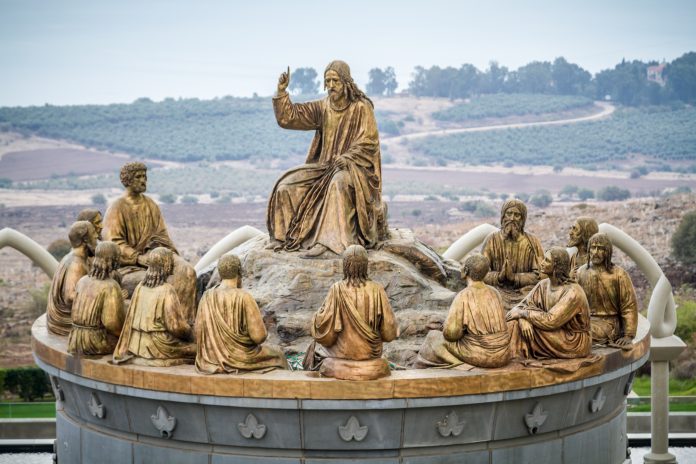
by Jeanne Heiberg
I had to smile when I read on a cereal box the claim that its contents include “grains on a mission.” If golden, healthy whole grains have a mission—to feed and nourish us—how much greater is the mission of Jesus and the sacred grains of the Eucharist that he gives us so that we might share in his mission, the mission that began when he was born on earth in a manger.
Like all of us, Jesus was not able to work at his mission when he first arrived on earth as a baby. At first he had to be cared for by his parents. He had to grow and learn and prepare before beginning what we call his public ministry. His mission began in earnest after he was baptized by John in the Jordan.
Jesus came to bring us into God’s kingdom—into unity with himself, with God the Father, and with all through Baptism. In Baptism, we receive a new life. In the Eucharist, we are nourished by the body of Christ. Nourished with Jesus’ Real Presence, we are empowered for our mission—and each and every one of us has a mission.
Mission in Scripture
In Sacred Scripture, the word mission is connected to the word sent or to send. The Gospel of John frequently speaks of Jesus being sent. He is a man with a mission, sent by God to accomplish God’s great work (John 6:38).
Jesus wanted to do the will of God; God’s will was more important to him than food. He said, “My food is to do the will of him who sent me” (John 4:34). Jesus was confident that he was not alone: “I am not alone, but it is I and the Father who sent me…What I heard from him I tell the world…I say only what the Father taught me…I always do what is pleasing to him” (John 8:16, 26, 28-29).
Faith in Jesus as the one sent by God means faith in the Sender—God the Father (see John 5:24; 17:3), whose presence is affirmed by sight and sound at his baptism. The Holy Spirit is seen coming down on Jesus in the form of a dove and the words of the Father are heard: “This is my beloved Son with whom I am well pleased” (Matthew 3:13-17).
Jesus was baptized just before his mission began, showing us that we also have a mission that flows from our own Baptism. We, too, are sent, having been baptized in the name of the Father and of the Son and of the Holy Spirit. As Jesus does the will of God the Father, so are we to do God’s will. Jesus said to his Apostles, “As my Father has sent me, so I send you” (John 20:21). This is how Jesus’ message spread throughout the whole world and has reached down through history to you and me. We are called to be Jesus’ witnesses in our own time and our own place (see Acts 1:8). This is the mission of Jesus, of his Apostles, and of his Church; that includes us.
Say to the Children
We celebrate Jesus’ birthday on December 25. We celebrate another important event in Jesus’ life a couple of weeks later, in January: his baptism in the Jordan River by his cousin John the Baptist. Jesus’ baptism began his public ministry of teaching, healing, and calling everyone to unity and oneness in God, our loving, heavenly Father. (Continue here with material from the previous text that is suitable for the age range of your students. End with:) Jesus had the greatest mission that ever was—and each of us has a part in that great mission.
Jesus needs us, wherever we are in time and place, to be a part of his great mission. This mission flows right from our Baptisms. Jesus insisted that John the Baptist baptize him so that we would know that we are not alone in our part of the mission. The Holy Spirit came down on Jesus in the form of a dove to let us know that the Spirit will always be with us—to lead and guide and inspire us, and to help us find new, fresh solutions to problems in line with God’s love.
At Jesus’ baptism, the voice of the Father was heard: “This is my beloved Son with whom I am well pleased.” When you hear the words “This is my beloved Son,” remember that you are God’s beloved as well! And when you hear “…with whom I am well pleased,” remember that God is “well pleased” with you, too. God created you out of love; he created you to love. You are a child of God. As God sent Jesus out with a mission, so God sends you out with a mission.
The next time you are at Mass, listen carefully to the words that the deacon or the priest says at the very end. You will hear something like “Go, you are sent forth” or “Go and announce the Gospel of the Lord.” These words have a message for you about mission and being sent. You are nourished at Mass for your mission, and when you leave the church, you live that mission.
To fulfill your mission, you probably will not be called to go to the ends of the earth the way the first Apostles were. Rather, your mission may be fulfilled in small and simple ways. Saint Thérèse of Lisieux, who lived in the nineteenth century, was nicknamed “the Little Flower” because she chose what she called “the little way” of doing small things to serve God. She did small acts of kindness, service, and love that you, too, can easily do. Her life has been an inspiration to millions of people who love her. In the twentieth century, Sister Thea Bowman, a Franciscan Sister of Perpetual Adoration, did great things in small ways. She called what she did “my little bit.”
Your mission will differ according to your gifts and talents and the stage of life you’re in. Right now, though, you can live your baptismal promises and share in Jesus’ mission by looking out for those around you, by being kind and looking for ways to be helpful. You can forgive hurts, pray for others, and extend friendship where you can. God wants you to be a smiling, happy person as a witness to the goodness and love in his Church.
You aren’t expected to do this on your own. Jesus was confident that God, our Heavenly Father, was always with him, and you can be confident that God—Father, Son, and Holy Spirit—is always with you, too. Jesus even gave assurance of his Real Presence to us in his body and blood, Holy Communion. He will nourish you in your mission. It makes me smile when a breakfast food claims to contain grains on a mission. The grains in the bread of the Eucharist have a far greater mission: to nourish you in your mission.
To help us recall the mission of Jesus and our own mission, we can make mobiles with three symbols: 1) a manger with a sun rising from it, as a symbol of Jesus coming to earth as an infant and his mission to bring us home to heaven; 2) a shell with water pouring from it, as a symbol of Jesus’ baptism in the Jordan and the beginning of his mission—and our own Baptisms; and 3) a cross, as a symbol of Jesus’ death and Resurrection which was the climax and completion of his mission and his handing on to us—his Church—the mission to live our baptismal promises to love God and others here and now.
ACTIVITY: Manger-to-Mission Craft
Materials
* copies of the three patterns (or plain paper and pencils/fine markers for students to design their own patterns) [CLICK HERE]
* card stock or construction paper
* images of people smiling and helping others (Catholic Relief Services material is a good source for these images, as are other Catholic publications) and color swatches from magazines and newspapers
* crayons, thin markers
* scissors
* glue sticks
* hole punch
* thin string
Procedure
1. Cut out the patterns. Trace around each pattern on pieces of card stock or construction paper. Cut them out.
2. Add detail to the manger and the shell. For example, color the wooded section of the manger and the sun; glue different colors of blue construction paper to the water pouring from the shell (you might even glue strips of tinfoil to a few sections of the water to add a sparkle effect).
3. Make the cross a Resurrection symbol by gluing onto it a collage of images showing people engaged in the mission of Jesus: being happy and doing kind things for others.
4. Punch a hole into the top and bottom of the cross and the shell, and into only the top of the manger. Using thin pieces of string, attach the three symbols together so that they will hang vertically. Attach a piece of string at the top of the cross so you can hang your mobile on a tree, from the ceiling of your classroom, etc.
Manger-to-Mission Prayer
On your prayer table, place the manger-to-mission crafts or hang them on the wall behind the prayer table. Also place on the prayer table a bowl of holy water and a Bible marked at the readings (see below).
Opening Song: “We Are Called” ©1988, David Haas. Gather, Third Edition, GIA Publications.
Opening Prayer: Lord Jesus, loving brother, by your baptism you taught us that our mission, in harmony with yours, flows from our own Baptisms. As the Father sent you to accomplish his will, so you send us to do his will and to accomplish our purpose. Help us to grow in obedience, faith, and love; and, at each stage of our lives, help us to discover the mission that will bring us joy.
All: Amen.
Readings: Isaiah 61:1-3 (the Lord sends us forth); Galatians 4:4-7 (God sent his Son to save us); Mark 16:14-20 (the Apostles are sent on their mission); John 20:19-22 (“As the Father has sent me, so I send you”)
Leader (Reflection and Baptismal Promises): When you were baptized, you probably were a tiny baby unable to say your own “yes” to the baptismal promises. Your parents and godparents said “yes” for you. However, every year at the Easter Vigil, and at other times, we renew our baptismal promises at Mass. At those times, you can say your own “I do” to the questions the priest asks.
The baptismal promises ask, “Do you reject Satan?” You say “I do.” (Have students say “I do.”) Satan is a pretty horrible reality that can really steal away happiness and ruin lives. Two more questions that follow ask if you reject all his works and empty promises. You say “I do.” (Have students say “I do.”) Satan has been called the Great Deceiver and the Father of Lies. Evil can look glamorous, exciting, and tempting on the surface, but in the end, it brings misery and devastation.
We don’t have to face the Great Deceiver alone. The next three questions in our baptismal promises are positive ones, geared to happiness and a full, rich life. “Do you believe in God the Father Almighty, creator of heaven and earth? Do you believe in Jesus Christ, his only Son, our Lord, who was born of the Virgin Mary, was crucified, died, and was buried, rose from the dead, and is now seated at the right hand of the Father? Do you believe in the Holy Spirit, the holy catholic Church, the communion of saints, the forgiveness of sins, the resurrection of the body, and life everlasting?” You say “I do.” (Have students say “I do.”) Your heartfelt commitment to live out these promises brings you into a great belonging in God’s family, into your mission to be one with Jesus, and into a meaningful and purposeful life.
(While you offer the Closing Prayer, have children, one by one, approach the prayer table, dip their fingers into the bowl of holy water, make the sign of the cross, and return to their places.)
Closing Prayer
Lord, help us to keep our eyes fixed on you, our ears open to your guidance, our hearts ready to serve. Help us to fulfill our mission with joy.
All: Amen.
Closing Song: “Take My Hands”. Text and music, Sebastian Temple, ©1967, OCP.
Jeanne Heiberg is the author of Advent Arts and Christmas Crafts (Paulist Press) and Advent calendars (Creative Communications). She is an artist, and has taught art, writing, creative catechetics, and meditation. She has taught all ages—Pre-K through college-age students and adult seniors—and has directed parish catechetical programs.
Copyright 2014, Bayard, Inc. All rights reserved. This article is protected by United States copyright and other intellectual property laws and may not be reproduced, rewritten, distributed, redisseminated, transmitted, displayed, published or broadcast, directly or indirectly, in any medium without the prior written permission of Bayard, Inc.
This article was written by the Catechist Staff and appeared in Catechist magazine, May 2014.
Image Credit: alefbet/Shutter Stock 559112293




